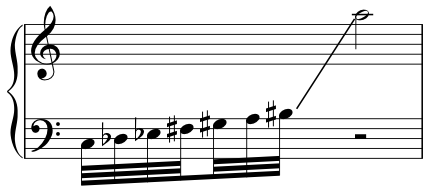Single glissando
Production
A single glissando is produced by sliding a finger horizontally over the strings. The second finger is used to slide upwards and the thumb to slide down. The sliding finger is kept in the middle of the strings.
Sound
A glissando sounds like a fast scale moving up or down.
Notation
Glissandi are notated with a thin straight line that indicates the direction and range of the glissando. The abbreviation: gliss. can be added for clarity but it is not mandatory. [Stone1980]
Start and/or end notes of the glissando should be put in parentheses if they are not be accentuated and should be omitted if the beginning or the end of the glissando is approximate.

Glissandi.
When the rhythmic value of the glissando is not clear from the context it may be necessary to add the glissando's duration above or below it.

Notating glissando duration.
When notating glissandi it is important to make it absolutely clear of which notes the glissando is comprised. This can be done by simply notating the required pedal setting with a pedal diagram at the beginning of the glissando.

It is also possible to write out in notes the first octave of the glissando to make the positions of the pedals clear. Traditionally thirty-second notes are used: [Inglefeld/Neill 1985]

Range
The left hand can play glissandi over the whole harp, but the right hand is limited in the low register. See right hand range.
Additional Remarks
Single glissandi can be played simultaneously in both hands, in the same or opposite directions.